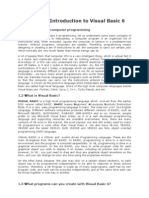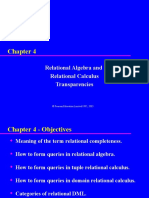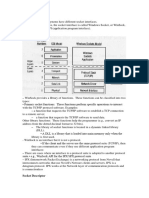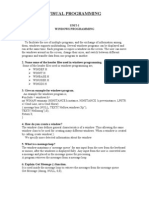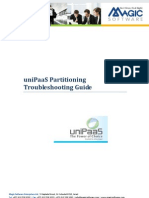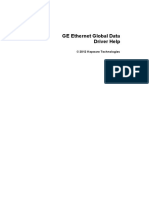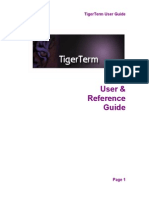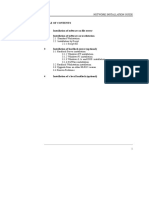Visual Programming - Question Bank
Uploaded by
Syedkareem_hkgVisual Programming - Question Bank
Uploaded by
Syedkareem_hkgVISUAL PROGRAMMING
UNIT-I
WINDOWS PROGRAMMING
1.Define multitasking.
To facilitate the use of multiple programs, and the exchange of information among
them, windows supports multitasking. Several windows programs can be displayed and
run at the same time. Each program occupies a window on the screen. The user can move
the windows around on the screen, change their sizes, and switch between different
programs and transfer data from one program to another.
2. Name some of the header files used in windows programming.
Some of the header files used in windows programming are,
WINDEF.H
WINNT.H
WINBASE.H
WINUSER.H
WINGDI.H
3. Give an example for windows program.
An example for windows program is,
# include < windows.h>
int WINAPI winmain (HINSTANCE h instance, HINSTANCE h preveinstance, LPSTR
s2 Cmd Line, int n Cmd Show)
{ message box (NULL, TEXT(“Hellow,windows Xp”);
TEXT(“Hellomsg”),0);
Return 0;
}
4. How do you create a window?
The window class defines general characteristics of a window. Thus allowing the same
window class to be used for creating many different windows. When a window is created
by calling create window( ).
We specify more detected information about the window.
5. What is a message loop?
The window maintains a ‘message queue’ for any input from the user from the keyboard
or mouse, after the windows is displayed fully. Any input from the user is converted into
a message and placed in the message queue for processing.
A program retrieves the messages from a message loop.
6. Explain Get Message ( ) function.
It is used inside the message loop to retrieve the messages from the message queue
Get Message (&msg, NULL, 0,0);
This function call passes a pointer to MSG structure to windows. The other parameters
specifty that the program needs all message for all windows created by the program.
7.Give the structure of MSG.
Typed of struct tag MSG
{HWND hwnd;
VINT message;
WPARAM wparam;
LPARAM lparam;
DWORD time;
POINT pt;
} MSG, * pmsh;
8. What is the purpose of window procedure?
The windows procedure determines what the window displays in its client area and how
the windows responds to user input. A window procedure can have any name.
A windows program can contain more than one window procedure. A window procedure
is always associated with a particular window class that you register.
Eg. LRESULT CALLBACK Wndproc (HWND hwnd, UNIT message, WPARAM
wparam, LPARAM lparam);
9. When does a window procedure receive a WM-PAINT message?
A window procedure receives a WM-PAINT message whenever one of the following
event occurs.
A hidden window brought into view by a mouse move on the window.
The program uses the Scroll Window or Scroll DC () unction to scroll part of its
client area.
The program uses the Invalidate Rect () or invalidating function to explicitly
generate a WM-PAINT message.
10. What is the purpose of WM-DESTORY message?
The WM-DESTROY message indicates that windows is in the process of destroying a
window based on a command from the user. The message is a result of the user clicking
on the close button or selecting close from the program’s system menu.
11. Which is the most commonly used text output function in GDI?
The most commonly used text output function is Text Out( ) which has the following
format.
Text Out (hdc,x,y,p* Text, length);
hdc -Handle to device context
x and y -Starting position of the character string
p*Text -Pointer to the character string
ilength -Length of the string in characters.
12. What is the use of device context handle?
The device context handle is the window’s passport to the GDI functions. With the
device context handle, we are free to paint the client area and update it is required.
13.What should be done after painting is finished?
After a program has finished painting its client area, it should release the device context
handle. When a program releases the handle, the handle is no longer valid and must not
be used.
14. Classify the GDI function calls.
The GDI function calls are classified into
Functions that get and release a device context.
Functions that obtain information about the device context.
Functions that draw something.
Functions that set and get attributes of the device context,
Functions that work with GDI objects.
15. What are mapping modes and transforms?
The GDI mapping modes allow us to draw in units of inches.
Millimeters or anything you want.
In addition windows-NT supports a traditional ‘world transform’ expressed as a 3-by-3
matrix. This allows for skewing and rotating of graphics objects.
16. What are metafiles?
A metafile is a collection of GDI commands stored in a binary form. Metafiles are used
primarily to transfer representation of vector graphic drawings through the clipboard.
17. What are the special features of scrollbars?
The special features of scrollbars are,
Scrollbars are one of the best features of a graphical user interface. They are easy
to use and provide excellent visual feedback.
Scrollbars can be used whenever we need to display anything text, graphics a
spreadsheet, database records, pictures, web pages-that requires more space than
is available in the windows client area.
18. Explain the two-step process in system message queue.
Windows till take the messages are by one from the system message queue and place it in
an application’s message queue only when a windows application has finished processing
a previous user-input message. This is a two step process-storing messages first in the
system message queue and then passing then to the application message queue. This
involves synchronization.
19. What are the windows ‘resources’?
Resources are data and they are often stored in a program’s EXE file but they do not
reside in the executable programs data area. In other words, the resources are not
immediately addressable by variables in the program’s code.
20What is windows programming?.
Windows using APIi for programming is called Windows Programming.
UNIT-II
VISUAL C++ PROGRAMMING INDRODUCTION
1.Name any four App wizards.
MFC appwizard(DLL and EXE)
Mfc ActivexX Control Wizard
ISAPI Extension Wizard
ATL Com Wizard
2. What are the working files needed to complete a VC++ application?
The working files needed to complete a VC++ application are,
DSK
OPT-Options file
DSP
CLW-class wizard
ODL-Object Description Language
MCB-No Compile Browser
README.TXT-Text file.
3. Explain MFC.
MFC-Microsoft Foundation Class.
The MFC, as the name suggests provides a set of reusable classes designed to simplify
windows programming. MFC provides on application framework, including the classes
that make up the application architecture hierarchy.
4. What is the use of application framework?
The application framework helps get our application running by providing program
initialization, passing windows messages to the appropriate places, and cleaning it up
when your application exists. The framework also provides a solid foundation for more
advanced features such as ActiveX and document/view processing.
5. Name the classes created by App wizard.
App wizard creates a hardful of classes based on the application name.
These full into the basic classes of,
Application classes
Document classes
View classes
Frame classes
6. What are Dialog boxes?
Dialog boxes are one of the primary methods that windows programs to display
information and receive input from users.
Modal
Modeless dialog boxes
are the two types of dialog boxes.
7. What is multithreading?
When any application (or process) starts, it has one primary tread. The application may
then start up additional threads which execute independently. All treads share the single
memory space of the process in which they are created. This technique is called
multithreading.
8. What are the key design goals of MFC?
The key design goals of MFC are,
Reduced efforts for writing windows applications.
Significant reduction in code size.
Ability to call native windows API functions directly from within the application
Easy to use powerful features such as database support,
Printing, creating tooth arc and status bars, creating ActveX controls.etc.
9. Give examples of mapping modes.
Examples of mapping modes are,
MM-TEXT
MM-HIENGLISH
MM-LOENGLISH
MM-HIMETRIC
MM-LOMETRIC
MM-TWIPS
10. What are ActiveX controls?
An Activex control is an COM-based object that can draw itself in its own window,
respond to events (such as mouse clicks), and be managed through an interface that
includes properties and methods similar to those in automation objects. The only
limitation on the kinds of ActiveX controls you can create is our imagination.
11.What is meant by control notification?
Control Notification are WM-COMMAND are message sent from child windows to their
parent window.
Eg. Edit control will send EM-CHANGE
12. What are Dialog Boxes?
Dialog Boxes are one of the primary method that window program to display information
and receive input from users.
13. What are modal dialog Boxes?
Modal dialog boxes require the user to respond before the application continues. These
modal dialog boxes can be stack so that one dialog boxes starts another thus forcing
control to the most recent dialog box and returning to the calling dialog box when closed.
14. What is a thread?
Thread is path or flow of execution through a process core. Threads give us ability to
execute different parts of the program at the same time.
15.When is worker thread created?
Worker thread created when there is any need to perform background tasks that receive
no direct input from the user
16. Define GDI?
The graphics device interface provides functions and related structures that an application
used to generate graphical output for displays, printers and other devices.
17. What is resource view?
Resource view allows us to find and edit each of various resources in the application
including dialog windows design, icons and menus.
18. What are ActiveX event handlers?
ActiveX event handlers can fire events back at our application. We can add events
handlers for the controls in the normal fashion by adding an event handler with class
wizard by the new windows messages/ event handlers dialog box.
19. What is a component gallery?
The component gallery is a collection of components that we can import into our
application to enhance it.
20.What is a class view?
Class view allows us to navigate and manipulate our source code on C++ class level.
UNIT III
The Document and View Architecture
1. What are the three types of menus?
The three types of menus are
1. Dynamic menus
2. Cascading menus
3. owner drawn menus
2. Which function adds menu items to a cascading menu?
The following function are used to add menu items in the cascading menus
a. CMenu :: Append Menu Items ()
b. Cmenu :: Append Menu ()
c. Cmenu :: Add Popup Items()
d. Cmenu :: Add Menu ()
3.What is status Bar ?
A status bar is a child window positioned at the bottom of the main window. It is
used to display context – sensitive help messages for menu items and toolbar buttons. It
also displays text messages such as ‘NUM’ to tell the user that NUM lock is on.
4.What are the three additional actions necessary to place a dockable toolbar?
After creating and loading the 3 additional actions necessary to place a docable
toolbar are,
a. Enable docking for the toolbar.
b. Enable docking for the frame window
c. Dock the toolbar to the frame window.
5.What are the functions provided by C document derived class?
The functions provided by C Document derived class are,
a. AddView()
b. UpdateAllView()
c. GetFirstViewPositional()
d. GetNextView()
e. GetPathName()
f. GetTitle()
g. IsModified()
h. SetModifiedFlag()
6.What is Frame window object?
The frame window object defines the application’s physical workspace on the screen and
serves as a container for the view.
7. What is a splitter window?
A splitter window is a basic window that can be divided vertically or horizontally or both
vertically and horizontally into two or more panes by movable splitter bars.
8.What are splitter window?
Static splitter windows require a little more work that dynamic splitter windows. In static
splitter windows , the panes are created when the window is created, and the order and
number of panes never can change. The panes are separated by a splitter bar than can
change the relative sizes of the panes.
9. List out the classes that provide functionality of rich edit control within the
context of MFC document view architecture?
a. CRichEditView
b. CrichEditDoc
c. CrichEditCntrlItem
10. What are DLLs
DLLs are compiled libraries which contain code , data and resources that can be attached
to application of run time. These libraries are implemented as separate files with default
extention dll and can be shared by several applications.
11. What are the advantages of DLLs?
DLL usage allows to save disk space because multiple application can share the same
dynamic library. In such systems, it is not necessary to rebuild application that use
particular DLL when this DLL is modified.
12. What is the use of :: GetProcAddress()?
This function is used to find the address for the individual functions before they are used.
If the function is not found, GetProcAddress() returns NULL. If the function is found,
this will return a generic pointer to a function.
13. Write about the memory issues of DLL?
In Win32, the DLLs memory is mapped ito memeory space of the loading process. Each
process gets its own copy of the global memory for the DLL, which is initialized when a
new process loads the DLL. This means that the DLL cannot be used to share memory
between processes in the way that Win 16 allows.
14. What is COM?
Component Object Model specifies architecture a binary standard and a supporting
infrastructure for building, using and solving component based applications. It extends
the benefits of object – oriented programming such as encapsulation, polymorphism, and
software reuse to a dynamic and cross-process setting.
15. What is DCOM ?
DCOM is the distributed extensions of COM. It specifies the additional infrastructure that
is required to further extend the benefits to networked environment.
16.What is the use of :: Load Library?
The first thing to load a DLL dynamically is to map the DLL module into the memory of
the process. This is done with the :: LoadLibrary() call, which takes a single parameter –
the name of the module to load.
17. What is the use of CrichEditView?
CrichEditView maintains the text and formalling characteristics of text.
18.Whaich call provides the functionality of rich edit control?
CrichEdit Ctrl class provides the functionality of rich edit control.
19.Define an interface.?
An interface is a collection of functionality related abstract methods and is identified by a
128 bit Gloabally Unique Identifier (GUID) called the interface ID .
20. Define an Object Class?
An Object class is a concrete implementation of one or more interface and is also
identified by a GUID called the class ID. The use of GUID allows programmers to
independently generate unique ID without requiring central authority.
UNIT IV
ACTIVEX AND OBJECT LINKING AND EMBEDDING (OLE)
1.What are ActiveX controls?
An ActiveX control is an COM-based object that can draw itself in its own window,
respond to events (such as mouse clicks), and be managed through an interface that
included properties and methods similar to those in automation objects. The only
limitation on the kinds of ActiveX Controls you can create is your imagination.
2. What are ActiveX event handlers?
ActiveX event handlers can fire events back to your application. You can add event
handlers for these controls in normal fashion by adding an event handler with class
wizard or by the new window messages/ event handlers dialog box.
3.What is DCOM?
Distributed Component Object Model specifies the additional infrastructure that is
required to further extend the benefits to networked environment.
4.Name any four features of COM?
The four Features of Com are,
1. Run-Time binary software reuse.
2. Architecture for extensibility.
3. Language neutrality.
4. Location Transparency.
5.Define an interface?
An interface is acollection of functionality related abstract methods and is identified by a
128 bit globally unique identifier (GUID) called the Interface ID (IID).
6.Define an Object Class?
An Object class is a concrete implementation of one or more interfaces and is also
identified by a GUID called the classID. The use of GUIDs allows programmers to
independently generate unique ids without requiring central authority.
7.Define remoting architecture.
Remoting architecture is the term used to refer to the entire infrastructure that connects
COM clients to out of process server objects.
8. What are MTAs and STAs?
MTAs – Multi Threaded Apartments.
STAs – Single Threaded Apartments.
9. What does the transparency feature of COM mean?
In the transparency mode, once the machine name is determined, COM will try to attach
to arunning server instance, hasting the requested object class, on that machine. If none
exists COM will automatically locate the server implementation file , start a server
process , and create an object instance.
10.What is containment/ delegation?
OLE offers two specific mechanisms for reusability containment/ delegation is
amechanism whereas’ outer ‘ object act as clients to ‘ inner’ objects acting as servers.
11. Define aggregation.
Aggregation is a mechanism which enables outer objects to expose interfaces from inner
objects , making it appear as if the outer object implemented those interfaces itself.
12.What is an ole document?
The most commonly known as of OLE technology is in the form of OLE containers and
servers. Together container and server applications enable users to manipulate, within a
single application, data coming from different sources and several applications.
13.What are OLE Controls?
OLE Controls are OLE Objects that provide an extended interfaces which implements the
behaviour of a windows control. OLE Control servers are typically implemented as in
process server.
14. What are the graphical representation used for interfaces and COM classes?
Interfaces are shown as small circles with lines attached to their class. The I Unknown
interface whichever supports is at the top and others are on the left.
15.Write any four clipboard related functions?
The four clipboard related functions are
a. Open ClipBoard()
b. Close ClipBoard()
c. GetClipBoardData()
d. SetClipBoardData()
16.How is the time saved in copying a large block of data that’s already in a disk
file?
The I Data Object interface specifies the storage medium of a data object formats.
Conventional clipboard transfer relies on global memory .The I data Object interface
permits transmission of a disk file name or a structure storage pointer instead. Thus if we
are to transfer a very large block of data that is already in disk file we don’t have to waste
time copying it to and from a memory block.
17. What is FORMATETC?
The FORMATETC structure is often is used instead of a clipboard format to represent
data format information. However unlike the clipboard format this structure includes
information about the target device. The aspects or view of the data and a storage
medium indicator.
18. Name any four functions of Idata Object Interface?
The four functions of Idata Object interface are
1. EnumFormatEtc()
2. GetData()
3. QueryGetData()
4. SetData()
19. Name the important member functions of the Cole Data source Class?
The member functions of the Cole Data source class are
a. CacheData()
b. CacheGlobalData()
c. DoDragDrop()
d. SetClipBoard()
20.What are Dll’s?
Dynamic Link Libraries are compiled libraries, which contain code data and resources
that can be attached to application at run time. These libraries are implemented us
separate files with default extension DLL and can be shared by several applications.
UNIT V :ADVANCED CONCEPTS
1. What is ODBC?
The Open Data base connectivity or ODBC. API is perhaps the most widely used
database interface for windows applications today. ODBC provides a standard
interface to a wide range of different sorts of data sources ranging from simple
text files to full blown database server systems.
2. What are the Recordset types?
The Recordset types are CRecordset ::Dynaset , CrecordSet ::SnapShot,
CrecordSet::Dynamic
3. Explain CrecordSet :: Dynamic Types?
This types uses a dynamic cursor which allows scrolling in both directions. Each
time when a new row is filtered from the record set changes can be observed in
the data values as well as any new records are changes in ordering.
4. Write about CREcordSet :: Dynaset
CrecordSet :: Dynaset uses a key set driver cursor and allows both forward and
backward scrolling. Whenever a new record is fetched our application will be able
to see any changes to the rows that were initially retrieved when the record set
was opened, but we will not see any additional rows that may be added by other
applications. The dynaset will also not reflect any changes to the ordering of the
rows within the recodrset
5. Give some egs for MIDI Messages?
Some egs for MIDI messages are
a. Note off
b. Note On
c. Polyphonic After touch
d. Control change
6. What are the database classes available for DAO?
The following classes are available for DAO are
1.C Dao WorkSpace
2.C Dao DataSpace
3.Cdao RecordSet
4.Cdao TableDef
5.Cdao Query Def
7.What are the advantages of OLEDB?
The advantages of OLEDB are
1.OLEDB is used to provide a uniform way to access all sorts of disporate data sources.
2. It is built on COM.
8.What are the various components that make up the OLEDB architecture?
Enumerators
Sessions
Commands
Errors
Data source objects
Transaction objects
Row sets
9.What are the advantages of OLEDB provider?
By writing a OLE DB provider
Clients cannot directly touch the data
Increases the data access performance by controlling jow the data is
manipulated
Increases the potential audience of our data.
10. What is the type of connection established by TCP?
The TCP protocol establishes a full duplex , point-to-point connection between
two computers and a program at each end of this connection uses its own port.
The connection is established by a three –way handshake.
11. How does HTTP work?
A server program listens on port 80. Then some client program connects
to the server after receiving the server’s IP address from a name server.
Using its port number, the client sets a two-way TCP connection to the
server.
Once connection is established, client sends a request to the server.
Server identifies the request and provides the server.
12. What is Winsock?
Winsock is the lowest level windows API for TCP.IP programming. Port of the
code is in W sock 32. DLL and Internet client and Internet server programs can be
written using Winsock.
13. What are the actions carried out in asynchronous Winsock
programming?
In the asynchronous mode,all sorts of hidden windows and peek message calls
enabled single-threaded programs to make Winsock send and receive calls
without blocking. Thus keeping the user interface alive.
14. What are the advantages of win Inet over winsock?
The advantages of win Inet over Winsock are,
1. Caching
2. Security
3. Web Proxy acess
4. Buffered I/O
5. Easy API
6. User Friendly
15. What are the two types of WinSock Programming?
1. Synchronous Winsock Programming
2. Asynchronous WinSock Programming
16. What is an Intranet?
An Intranet is often implemented on a company’s LAN ans is used for distributed
application.
17. What is a socket?
The combination of an IP address and a port number is called a socket.
18. What are the two types of OLE DB providers?
The two types of OLEDB Providers are
1. Data Providers.
2. Service Providers
19. What are the fundamental units of Internet communication?
The IP protocol defines packets called datagrams that are fundamental units of
Internet communication.
20.Name some of the Win Inet Classes?
Some of the WinInet Classes are
1. C internet session
2. C Http Connection
3. CFtp Connection
4. C Gopher Connection
5. C Internet File
6. C HTTP file.
PART-B
UNIT 1
1. What are the various functions used for basic drawing in a windows program? Explain in
detail?
2. Write short notes on:
i. WinMain()
ii. WndProc()
3. Explain the architecture of a windows program with a sample
program.
4. Explain in detail the various child window controls.
5. What is GDI? Explain in detail the basic drawing functions used in windows programming?
UNIT 2
1. Explain the various mapping modes used in visual C++ programming.
2. What are the various common controls and dialogs available for programming in
windows? Explain in detail.
3. Explain in detail how the two types of dialog boxes are created with an example.
4. Write short notes on:
a. Applicaton framework.
b. MFC library.
5. Write short notes on:
i. Visual C++ components.
ii. Event handling.
UNIT 3
1. Explain in detail about keyboard acceleration .
2. Write short notes on:
i. Creating DLLs
ii. RichEdit Controls.
3. What are the various functions related to creating and updating menus available in
visual C++? Explain in detail.
4. Explain in detail how DLLs are created and used in windows programming.
5. Write short notes on:
i. Splitter window and multiple views.
ii. Toolbar.
UNIT 4
1. Write in detail how OLE embedded components and containers are used in windows
programming.
2. Explain how OLE drag and drop is done with visual C++.
3. Explain hoe ActiveX controls are different from ordinary windows controls in detail
4. Write short notes on:
i. COM
ii. OLE
5. Write short notes on:
i. Component object model
ii. Containment and aggregation Vs Inheritance.
UNIT 5
1. Explain the various functions related to database control in detail?
2. Explain about DAO concepts?
3. Explain about Winsock and winInet?
4. Explain about ISAPI server extension?
5. Explain low sound and video files are used in visual C++ programming?
6. Explain in detail the various MFC ODBC classes.?
7. Write short notes on:
i. Chat application.
ii. Calendar control.
8. Explain how the concept of threading is used in visual C++ with suitable example?
You might also like
- Ian Gibson-Software Solutions For Rapid Prototyping-Wiley (2002)100% (1)Ian Gibson-Software Solutions For Rapid Prototyping-Wiley (2002)399 pages
- Fill in The Blanks:: Advanced C++ & Data Structures (Solved)No ratings yetFill in The Blanks:: Advanced C++ & Data Structures (Solved)24 pages
- Distributed Systems Chapter 3-ProcessesNo ratings yetDistributed Systems Chapter 3-Processes33 pages
- Master The Art of Subnetting - 45 MCQ With Detailed ExplanationsNo ratings yetMaster The Art of Subnetting - 45 MCQ With Detailed Explanations15 pages
- Yearly BCA Old Question Papers of Third Semester - Web TechnologyNo ratings yetYearly BCA Old Question Papers of Third Semester - Web Technology2 pages
- 250+ TOP MCQs On Database Design Process and AnswersNo ratings yet250+ TOP MCQs On Database Design Process and Answers7 pages
- 29 Bits Identify The Network, 3 Bits Identify The HostNo ratings yet29 Bits Identify The Network, 3 Bits Identify The Host1 page
- Object Oriented Programming Using C++ Second Year Sem II: Two Marks Questions100% (1)Object Oriented Programming Using C++ Second Year Sem II: Two Marks Questions6 pages
- End Term Examination: Paper Code: BBA - 107 Subject: Computer Fundamentals Paper IDNo ratings yetEnd Term Examination: Paper Code: BBA - 107 Subject: Computer Fundamentals Paper ID5 pages
- Subnetting Practice Answers: Comp 11 - Chapter 10No ratings yetSubnetting Practice Answers: Comp 11 - Chapter 101 page
- Vlsi Design: III B. Tech II Semester Regular Examinations, April/May - 2019100% (1)Vlsi Design: III B. Tech II Semester Regular Examinations, April/May - 20194 pages
- Engineeringinterviewquestions Mcqs On Requirement Engineering AnswersNo ratings yetEngineeringinterviewquestions Mcqs On Requirement Engineering Answers6 pages
- Different Operating Systems - GeeksforGeeksNo ratings yetDifferent Operating Systems - GeeksforGeeks22 pages
- Introduction To Visual Studio IDE With FeaturesNo ratings yetIntroduction To Visual Studio IDE With Features10 pages
- Answer: A: Department of Information Technology UNIT-II-CAO-MCQ B.Tech 4 SEMNo ratings yetAnswer: A: Department of Information Technology UNIT-II-CAO-MCQ B.Tech 4 SEM4 pages
- "Web Applications Design" Selected Multiple-Choice QuestionsNo ratings yet"Web Applications Design" Selected Multiple-Choice Questions3 pages
- The Integrated Development Environment: Microsoft Visual Basic 6.0 History of Basic100% (1)The Integrated Development Environment: Microsoft Visual Basic 6.0 History of Basic18 pages
- A College Student's Guide To Computers in EducationNo ratings yetA College Student's Guide To Computers in Education107 pages
- Visual Programing - TutorialforArraysandListsNo ratings yetVisual Programing - TutorialforArraysandLists33 pages
- IGNOU MCA MCS-21 Solved Assignments 2011No ratings yetIGNOU MCA MCS-21 Solved Assignments 201117 pages
- Visual Programming - MFC-OLE-COM ConceptsNo ratings yetVisual Programming - MFC-OLE-COM Concepts36 pages
- Chapter 8 - Searching and Sorting Arrays: Starting Out With C++, 3 EditionNo ratings yetChapter 8 - Searching and Sorting Arrays: Starting Out With C++, 3 Edition36 pages
- Hidden Surface Removal - Computer GraphicsNo ratings yetHidden Surface Removal - Computer Graphics10 pages
- 6 CSE455 2D Normalization and Viewing TransformationNo ratings yet6 CSE455 2D Normalization and Viewing Transformation19 pages
- Relational Algebra and Relational CalculusNo ratings yetRelational Algebra and Relational Calculus57 pages
- Computer Graphics - Visible Surface DetectionNo ratings yetComputer Graphics - Visible Surface Detection15 pages
- Computer Graphics - 3-Dimensional Transformations - Applied To SurveyingNo ratings yetComputer Graphics - 3-Dimensional Transformations - Applied To Surveying23 pages
- Computer Graphics - Hidden Surface Removal Using Polygon Area SortingNo ratings yetComputer Graphics - Hidden Surface Removal Using Polygon Area Sorting9 pages
- Computer Graphics - Hidden Surface Elimination100% (1)Computer Graphics - Hidden Surface Elimination68 pages
- Computer Graphics - Two-Dimensional Viewing100% (3)Computer Graphics - Two-Dimensional Viewing22 pages
- Database Management System From SanfoundryNo ratings yetDatabase Management System From Sanfoundry98 pages
- Lab6 - C - Plus - Plus - Assisted - ExploitationNo ratings yetLab6 - C - Plus - Plus - Assisted - Exploitation19 pages
- Differences between socket programming on Windows, Linux, and macOSNo ratings yetDifferences between socket programming on Windows, Linux, and macOS4 pages
- Winsock Programmer's FAQ Articles: Debugging TCP/IPNo ratings yetWinsock Programmer's FAQ Articles: Debugging TCP/IP4 pages
- SmartSniff - Packet Sniffer - Capture TCP-IP Packets On Your Network AdapterNo ratings yetSmartSniff - Packet Sniffer - Capture TCP-IP Packets On Your Network Adapter9 pages
- An Introduction To Internet Programming PDF67% (3)An Introduction To Internet Programming PDF27 pages
- Windows Socket Programming in C - Biniam Fisseha100% (1)Windows Socket Programming in C - Biniam Fisseha18 pages
- 1 Installation of Software On File Server 2 Installation of Software On WorkstationNo ratings yet1 Installation of Software On File Server 2 Installation of Software On Workstation13 pages
- Ian Gibson-Software Solutions For Rapid Prototyping-Wiley (2002)Ian Gibson-Software Solutions For Rapid Prototyping-Wiley (2002)
- Fill in The Blanks:: Advanced C++ & Data Structures (Solved)Fill in The Blanks:: Advanced C++ & Data Structures (Solved)
- Master The Art of Subnetting - 45 MCQ With Detailed ExplanationsMaster The Art of Subnetting - 45 MCQ With Detailed Explanations
- Yearly BCA Old Question Papers of Third Semester - Web TechnologyYearly BCA Old Question Papers of Third Semester - Web Technology
- 250+ TOP MCQs On Database Design Process and Answers250+ TOP MCQs On Database Design Process and Answers
- 29 Bits Identify The Network, 3 Bits Identify The Host29 Bits Identify The Network, 3 Bits Identify The Host
- Object Oriented Programming Using C++ Second Year Sem II: Two Marks QuestionsObject Oriented Programming Using C++ Second Year Sem II: Two Marks Questions
- End Term Examination: Paper Code: BBA - 107 Subject: Computer Fundamentals Paper IDEnd Term Examination: Paper Code: BBA - 107 Subject: Computer Fundamentals Paper ID
- Vlsi Design: III B. Tech II Semester Regular Examinations, April/May - 2019Vlsi Design: III B. Tech II Semester Regular Examinations, April/May - 2019
- Engineeringinterviewquestions Mcqs On Requirement Engineering AnswersEngineeringinterviewquestions Mcqs On Requirement Engineering Answers
- Answer: A: Department of Information Technology UNIT-II-CAO-MCQ B.Tech 4 SEMAnswer: A: Department of Information Technology UNIT-II-CAO-MCQ B.Tech 4 SEM
- "Web Applications Design" Selected Multiple-Choice Questions"Web Applications Design" Selected Multiple-Choice Questions
- The Integrated Development Environment: Microsoft Visual Basic 6.0 History of BasicThe Integrated Development Environment: Microsoft Visual Basic 6.0 History of Basic
- A College Student's Guide To Computers in EducationA College Student's Guide To Computers in Education
- Chapter 8 - Searching and Sorting Arrays: Starting Out With C++, 3 EditionChapter 8 - Searching and Sorting Arrays: Starting Out With C++, 3 Edition
- 6 CSE455 2D Normalization and Viewing Transformation6 CSE455 2D Normalization and Viewing Transformation
- Computer Graphics - 3-Dimensional Transformations - Applied To SurveyingComputer Graphics - 3-Dimensional Transformations - Applied To Surveying
- Computer Graphics - Hidden Surface Removal Using Polygon Area SortingComputer Graphics - Hidden Surface Removal Using Polygon Area Sorting
- Differences between socket programming on Windows, Linux, and macOSDifferences between socket programming on Windows, Linux, and macOS
- Winsock Programmer's FAQ Articles: Debugging TCP/IPWinsock Programmer's FAQ Articles: Debugging TCP/IP
- SmartSniff - Packet Sniffer - Capture TCP-IP Packets On Your Network AdapterSmartSniff - Packet Sniffer - Capture TCP-IP Packets On Your Network Adapter
- 1 Installation of Software On File Server 2 Installation of Software On Workstation1 Installation of Software On File Server 2 Installation of Software On Workstation





































































